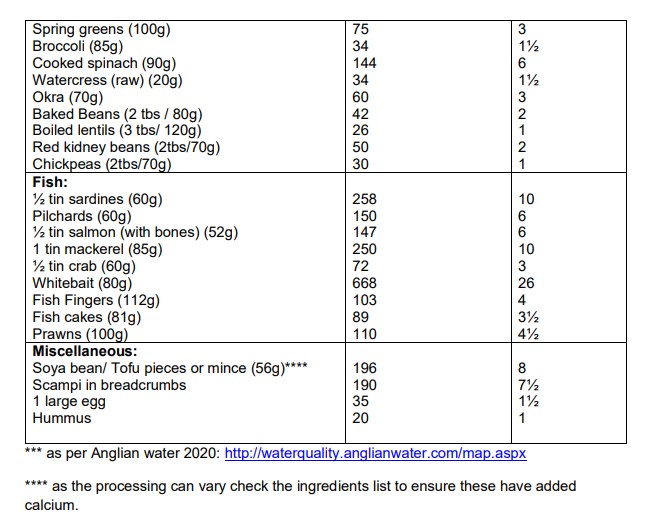Sources of Calcium for a cow’s milk free diet
Please note, this page is printable by selecting the normal print options on your computer.
Why do we need calcium?
This important mineral is the main component for bones and teeth. It is important to have an adequate amount of calcium throughout our lifespan. Children and adolescents build up their bone mass until they reach their early twenties. After this time bones gradually weaken. Therefore, calcium should be optimised during childhood and the teenage years to ensure bones are as strong as they can be. Cow’s milk and dairy products are the biggest sources of calcium for UK diets. Therefore, it is important to ensure enough calcium from alternative sources if following a cow’s milk-free diet or you may be risking deficiency and weakened bones. If you do not feel your child is achieving their calcium requirements every day (see overleaf) then an over the counter supplement may be recommended.
Vitamin D
It is important to have enough Vitamin D as it helps the body to absorb calcium from foods eaten. The main source of this vitamin is through the action of sunlight on skin during the summer months. There are small amounts of vitamin D are found in some food such as oily fish, eggs and foods fortified with vitamin D such as margarine.
Should my child take additional supplements?
The Department of Health recommends
• All breast-fed babies should be given a daily supplement containing up to 10µg vitamin D from birth.
• Infants fed on formula do not need an additional supplement of vitamin D unless they are receiving less than 500ml of formula per day.
• All children aged under 5 years should take a daily supplement containing vitamins A, C and 10µ of Vitamin D.
• Everyone aged 5 years and older should consider taking a daily supplement containing 10µg of vitamin D between the months of October – March.
It is especially important that young children are given their vitamin drops as they are learning to eat a variety of foods and may go through periods of fussy eating. These can be purchased from supermarkets, chemists, and health food shops.
Dairy free sources of calcium:
If you or your child are allergic or intolerant to milk, other cow’s milk free sources of calcium include:
• Calcium Fortified dairy free plant drinks or ‘milks’ such as soya milk, rice milk*, oat milk, almond milk, hazelnut milk, hemp milk, coconut milk, pea milk etc**.
• Fortified dairy free plant-based products e.g. soya or coconut-based yogurts, cheeses, creams and custards etc.
• Fortified breakfast cereals e.g. mixed grain hoops, hot oat cereals and porridge.
• Bread (white and brown flour is enriched with calcium which makes them better sources than wholemeal bread).
• Bakery products e.g. dairy free crumpets, muffins rolls and bagels made with white or brown flour.
• Pulses e.g. beans, baked beans, lentils and tofu (soya bean curd).
• Tinned fish (eat the bones) e.g. sardines, pilchards, mackerel and salmon.
• Fish paste.
• Green leafy vegetables e.g. cabbage, spinach, kale, watercress etc.
• Nuts and seeds e.g. sesame seeds and tahini.
• Oranges.
• Dried fruit e.g. dried figs, dried apricots and raisins.
• Eggs.
• Products that are fortified with extra calcium e.g. some bottled water and orange
juice.
• Hard tap water e.g. Milton Keynes tap water.
*Rice milk is not recommended for children under 5 years.
**Some of these options can be higher in sugar. Ensure that you brush your child’s teeth
regularly to prevent dental problems.
‘Organic’ options are often not fortified with extra calcium.
How much calcium do I/ my child need?
Daily calcium requirements are summarised in the table below:

Calcium content of dairy free foods:
The amount of calcium in average portion sizes is given which has also been converted into calcium points. You can add up the calcium points of the foods you or your child eats during the day to check against the recommended calcium intake. Always check the ingredients labels of foods to ensure that they do not contain traces of milk and to confirm that a ‘fortified food’ is also fortified with calcium.


Example meal plan:
Breakfast: Fortified cereal with Fortified plant milk and fruit Toast and dairy-free spread and glass of fortified dairy free milk
Mid-morning: Fruit or fortified dairy free yogurt
Lunch: Sandwich with dairy free spread and tinned fish/egg
Baked beans on brown toast
Omelette made with fortified dairy free milk and green vegetables
Mid-afternoon: Toasted English Muffin and orange
Pitta bread, vegetable sticks and hummus
Evening meal: Stir-fry with prawns/tofu, nuts and green vegetables
Fish fingers with baked beans, potatoes and broccoli
Curry with lentils, chickpeas, spinach and dairy free chapati
Before Bed: Fortified dairy free milk.
